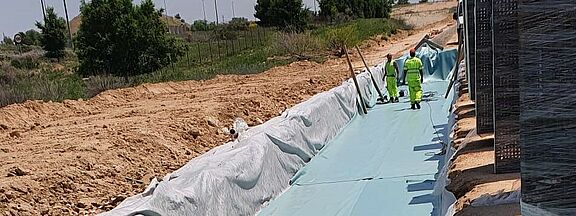Stormwater tanks Madrid - Ahijones
- Project – Stormwater attenuation tanks and rain gardens
- Location – Madrid- Ahijones
- Installation dates – May-November 2020
- Owner – ALDESA
- Installation company – Orion Túneles
- Type of works – Waterproofing of the stormwater attenuation tanks and construction of the rain gardens
- Product – RENOLIT ALKORPLAN Tunnel C 35034 1.50 mm thick, covering a total of 10,550 m2
In new urban models, the use of technology to fight against and revert the effects generated by climate change is becoming increasingly more necessary. Sustainable construction models are now here to stay. This progress has brought with it an improvement in the quality of life for people, but not in the quality of the air we breathe. For this reason, researchers are directing their efforts into reducing CO2 levels. Industry professionals are constantly searching for new, environmentally friendly construction methods. Examples in the urban development in the Southeast of Madrid - Ahijones, demonstrate that construction and the environment can be combined in a sustainable way. To build in an ecological way, it is vital that the right materials are used.
The challenge
The development in the Southeast of Madrid faced a series of urban challenges due to, in part, the excessive population density in the zone.
Technicians and the administration have been able to search for an alternative to traditional urban drainage systems. In this case, they have opted for a half-pipe drainage system that covers the zone. Designed as stormwater attenuation tanks, these pipes will collect part of the rainwater, being able to regulate this water flowing to nearby treatment plants, without any risk of collapsing the system. Rain gardens have also been incorporated which will enable water treatment using natural methods and its reuse for watering parks and gardens.
The solution
The stormwater attenuation tanks have long been the solution for preventing damage caused by heavy downpours. Correct sizing is the key to them functioning correctly, i.e., defining the storage volume appropriate to each geographical context and to each environmental issue. Historically, these tanks were defined as large underground structures, generally made of concrete and associated with very high constriction and maintenance costs.
In the last few years, these types of installations have been able to be simplified thanks to the emergence of modular systems, designed to enable rainwater management which, in turn, reduces the risk of floods and harming the environment.

These types of Sustainable Urban Drainage Systems (SUDS) bring numerous advantages, among which the following stand out:
- Large storage volume, with a void percentage of 95%.
- Compression resistance of 80,000 kg/m2
- Simple male female joints which allow the tanks to be modulated according to the needs and geometry of the excavation
- Easy to maintain
- Low installation cost
This type of deposit allows excess water caused by rain to be stored correctly, either as a temporary storage tank or an infiltration tank. Among its applications we highlight:
- Control of excess rainwater
- To store, infiltrate or rainwater runoffs
- Manage rainwater discharged from other systems: domestic or industrial roof drains, plastic pipes, ditches, separators, and parking lot drainage channels.

From a technical point of view, these receptacles allow the collection of rainwater from both water collectors and from surface runoffs. This system of crates forms an underground structure that must be waterproofed to prevent the flushing of the base support, the filtration of untreated water and the loss of water resources. These waters infiltrate through the upper part of the reservoir (passing through various substrates and draining materials), given that this side is not waterproofed. In turn, these types of SUDs have an overflow that connects to the outlet chamber in the event of saturation.
Similarly, they have a bottom drain that allows them to be emptied into the said chamber for its subsequent reuse.
This system contains the following elements:
- Geotextile material as a puncture resistant layer, installed on a bed of sand which, in turn, helps towards protecting the sheet which is installed on the said felt.
- RENOLIT ALKORPLAN Tunnel C 35034 waterproofing sheet made from flexible vinyl polychloride (PVC-P), homogenous (not reinforced), 1.5 mm thick, elongation at break ≥300% (EN ISO 527-3), with static puncture resistance (CBR in accordance with EN ISO 12236) ≥2,30 kN and resistant to punctures by roots. With the CE mark according to the specific standard for hydraulic works EN 13361. The welding between sheets or accessories are carried out using thermal fusion. The sheet envelops the modules, leaving a central-top opening to allow filtration.
- Separator and protective layer around the drainage tank deposits, using a 250 gr/m2 non-woven geotextile, with static puncture resistance (CBR in accordance with EN ISO 12236) ≥3.33 kN and dynamic puncture resistance (EN ISO 13433) 15 mm, made up of 100% virgin polypropylene fibers, mechanically joined by a needle-punched process with subsequent thermosetting. With the CE mark according to the standard EN 13254.
The result
By using a proper waterproofing system, water erosion is prevented. The flushing of material results in the loss of its particles due to fragmentation and abrasion, with subsequent displacement, generating a loss of stability in the upper layers. In addition, proper waterproofing prevents the filtration of contaminating waters into the aquifers.
Improving the management of runoff water should be the goal for the coming years. This improvement would reduce the risk of damage from torrential rains and make it possible to treat urban runoff water.
The latter improvement would be a short-term goal, which could be achieved with sustainable urban drainage and storage systems.
This would avoid episodes of discharges of untreated water and reduce treatment costs.

